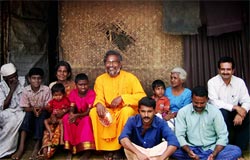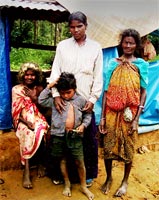The Amrita Kripa Charitable Hospital for Tribal
Kalpetta, Kerala
Kalpetta, the capital of the Wayanad district in north Kerala, is reached by following steep roads that wind through densely forested mountains. The region has been inhabited for at least 12,000 years. The indigenous people who still inhabit this area are the Adivasis: meaning, the first inhabitants, also known as “tribal.”

Throughout India, the tribal population is suffering. In Wayanad, their history is steeped in tragedy. Once welling in simplicity in the majestic silence of the land, many of the district’s tribals became slaves and today many live in a state not far removed from that. A people who were once healthy and long-lived, they now suffer from severe malnutrition and untreated diseases.
Exploitation by English colonists, abuse and degradation of the environment, a general lack of understanding and respect by the dominant community… the historical reasons for this tragedy are complex. The condition of the Adivasis was hurt even more by 1994’s World Trade Agreement, which effectively lowered the prices on the district’s main cash crops of coffee, tea and spices to such an extent that many plantations were forced to shut down. The main source of employment for Adivasis is as day labourers on plantations, earning around 50 rupees [a little more than a dollar] a day. The shortage of plantation work has found many dying from starvation or malnutrition.

Amma’s Ashram has been working in tribal areas for years, trying to help these people out of their desperate situation. Many of the children who live at the Ashram’s orphanage in Paripally are tribals, and in the Wayanad District, the Ashram runs small tribal schools, mobile medical camps, vocational education and regularly distributes food and clothing. The Amrita Kripa Hospital for tribals in Kalpetta is the Ashram’s latest effort to relieve the suffering of these people. It is the Ashram’s hope to guide the Adivasis onto the path towards a healthy lifestyle and economic independence. It also hopes to help them preserve the many positive aspects of their traditional lifestyle that have gone unrecognised and unappreciated and are in danger of being lost.
Guided by Brahmachari Akshayamrita Chaitanya, who Amma has put in charge of the Wayanad District, we visited some tribal homes in the vicinity of the hospital last November.
Our jeep ploughed through an almost nonexistent road, gone muddy from recent rains. To our right, about 50 feet below, flowed a muddy river. On our left, in a clearing in the forest, were simple dwellings. They ranged from solid-looking brick buildings to thatched huts, to one fashioned from a simple tarpaulin stretched over a crumbling foundation. This last home was occupied by two old ladies and a young woman. The day-labour wages of the young woman was the family’s sole support.
We stopped the jeep and proceeded along a path. At the next simple house we visited, a woman asked Br. Akshayamrita to do a puja [ritual worship]. She had draped a white cloth on a low ledge, upon which she had placed a small photo of Amma, an oil lamp and a few brilliantly red hibiscus flowers. Br. Akshayamrita did a simple puja, to the joy of the lady. At each house, the people were happy to see us and invited us in. Br. Akshayamrita distributed sweets and asked after the welfare of the people. At one house, the men showed us a traditional Adivasi bamboo bow and the different types of arrows used for hunting. Now the Adivasis are forbidden to hunt on their own native lands.
Later at the Kalpetta hospital, we met Dr Sanjiv and Dr Ajita, a husband-and-wife team who were instrumental in setting up the hospital. The three doctors went to work treating the steady stream of patients who had come long distance by bus or foot for the treatment of a variety of ailments. The most common complaints of the Adivasis are cuts, infections, parasites, anaemia and the host of ailments that stem from malnutrition.
None of the patients we saw had life-threatening illnesses, but when you live in squalor in this part of the world, even a small injury or bad case of parasites can have serious consequences–not to mention that a day spent in the sickbed is a day of no income. For example, Naryanan, age 60, supports his wife and two children by working in the fields as a day labourer. He is his family’s sole source of income. His toe became infected while working in the muddy fields. He had been going to the Government Hospital for the past month, but his condition had still not improved. The Ashram doctors removed part of his toenail and treated the infection with antibiotics. He told us that he feels better and is happy with his treatment at the hospital. Like most patients, he came by bus and foot–even with his bad toe. The average patient undertakes a two-hour journey to reach the hospital. Some even travel four.

Sarojini also came with an infected toe, stemming from an accident with a knife while working in the fields of a coffee estate. She came to Amrita Kripa because she has little money. Prior to her injury, she had been attending the hospital’s weekly bhajan session. She explained to us that this helped her to feel comfortable to come here. She told us that she has heard about Amma and is learning some of Amma’s bhajans from her three teenaged children. While interviewing her, we discovered that she has a teenage daughter who has been disabled from severe childhood burns. The doctors encouraged her to bring the shy girl to the hospital so that they can assess her condition
During our visit, many Adivasis came with gastric complaints, severe anaemia, upper respiratory infections, joint problems and parasites. We met a Muslim woman who had gained the confidence to come after her daughter reported having a good experience with her treatment. It seems obvious that only after one month of operation, the hospital is already actively serving the area in a variety of ways.
Long-term plans include a community outreach program, speciality medical camps, extending the services offered to include inpatient treatment and a full range of services including cardiology, obstetrics and gynaecology, gastrology, ophthalmology, etc. Plans are underway for senior residents and interns from AIMS Medical College to provide rotating staff for some of these services.
Located on a large piece of property, the Amrita Kripa Charitable Hospital is well placed for expansion. Its location–adjacent to major highways leading to Mysore and Bangalore, while still being close enough to Kalpetta’s centre–should also ensure that those who need it can easily come to known of it and to avail of its services.
The hospital’s small staff radiates a warm concern and sweetness towards the patients. We could see the wariness and concern of the patients dissipate as they interacted with the doctors and the staff. Healing–on many levels–is clearly taking place here.
We left convinced that through the dedication and loving attitude of the doctors and staff, the strong relationship between the Adivasi community and Br. Akshayamrita, and the grace of Amma, this project will make a major impact on the difficult lives of these sweet and simple people.
A few weeks after our visit, we met some people from Wayanad at the Amritapuri Ashram. They had just finished a course at AIMS Hospital to become community health workers. They were taught simply procedures such as how to check someone’s blood pressure and blood sugar levels. They were also taught how to give instructions on basic healthcare and sanitation. Graduates from the programme, earn 1500 rupees a month doing this valuable work. They all had graduated the 10th standard [the equivalent of high-school graduates]. Community outreach is a crucial part of the Charitable Hospital in Kalpetta’s goal towards improving the health of the local people, and this programme is expected to continue to expand.
In August 2005, after 11 months of operation, the Charitable Hospital in Kalpetta has expanded its services enormously. In this first year, the hospital’s doctors have seen a total of 11,333 patients. Of these 6,780 were tribals. All services for the tribals are free, and others receive treatment at a reduced rate. All patients are seen, regardless of their ability to pay. A measure of the confidence the local people have in the treatment they are receiving can be seen by the number of repeat visits, which number 7,288. Currently, the hospital sees, on average, 123 patients a day. Twenty-eight medical camps have been held in this first year of operation. Additionally, the hospital is offering telemedicine consultation with AIMS Hospital for complicated cases.
–Rita & Gitamba
